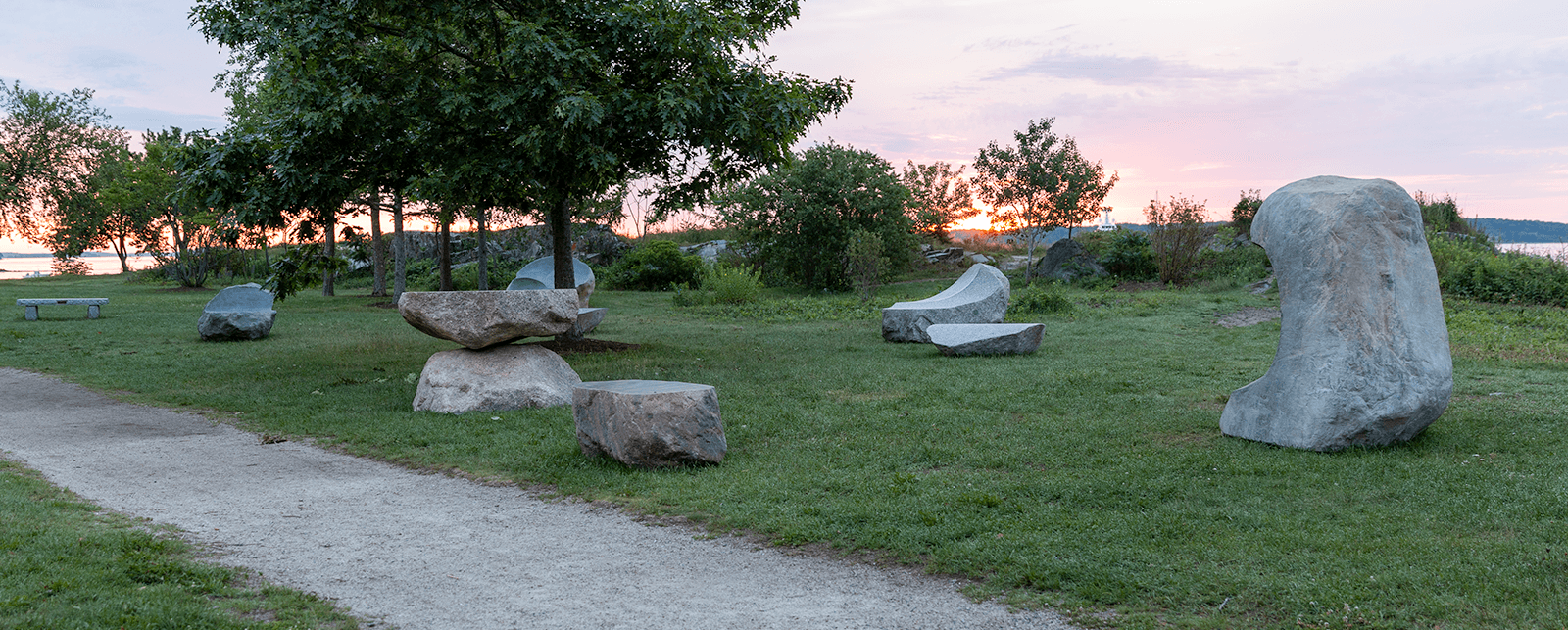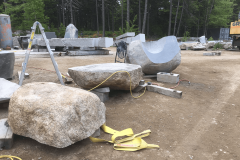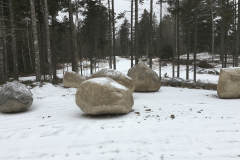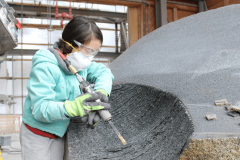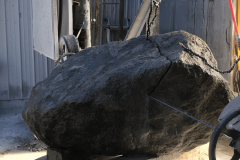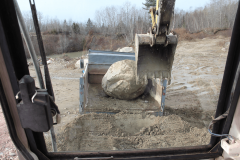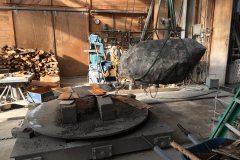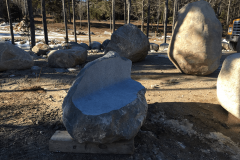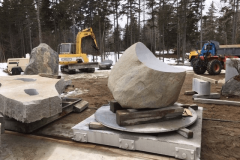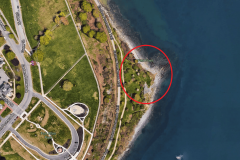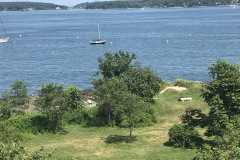Gathering Stones by Jesse Salisbury, (2020)
Materials: Granite and Basalt stone | Weight: 38,500 lbs
Imagine an arrangement of large stones magically appearing on the Eastern Promenade. It’s as if they levitated from nearby fields and beaches to surprise morning walkers. Mysteriously shaped, and playfully arranged, they become a gathering place.
Large granite and basalt stones form Jesse Salisbury’s Gathering Stones. Weighing from 4,000 to 12,000 pounds each, the stones are split, and carved into different shapes. The shapes create a space that encourages interaction. Some stones are hollow inside, encouraging people to walk through them or sit inside them. Some are convenient for sitting on. You can step from stone to stone. Feeling at once primitive and futuristic, it encourages people to explore with others.
We have an innate desire to collect and arrange stones that we find in nature. Arranging large stones creates a gathering place for people. Gathering Stones is a playful reference to both impulses.
The Artist
Jesse Salisbury grew up on the rural and rock bound coast of Maine and was influenced by this dynamic geology and natural beauty from an early age. He began carving wood with a local professional artist while in grammar school.
Jesse began his formal artistic training in Japan where he apprenticed with renowned traditional ceramic artists Ren and Mami Katayama, contemporary sculptors Katsumi Ida and Atsuo Okamoto and others. He worked as a professional assistant and translator at the Yonago International Sculpture Symposium in Tottori, Japan.
Beginning in 2005 Jesse founded and served as director of the Schoodic International Sculpture Symposium which organized the creation of sculptures by National and International artists for a public collection of 34 sculptures that spans three counties in Eastern Maine. After a decade of developing his own sculptures and founding a major public art event, Jesse is now focused on developing his sculptures on an even larger scale, and in the public realm, in projects that fuse landscape and art, and require collaboration, communication, efficiency, and integrity. Learn more about the artist and his work.
Artist Statement
The natural rocky landscape of Maine has been a strong influence on my art work from an early age. It first inspired me to begin carving and continues to influence the development of my work and style. The wide open spaces of Maine and the durable nature of the granite bedrock has helped to lead me in a direction of creating large scale outdoor sculpture. Collaborative projects and public art attracted me early on as a path for making larger time consuming works. I began developing sculpture symposiums in Maine starting in 2004 and worked for more then a decade to create a collection of public works during five biennial sculpture events. I gained invaluable experience in a variety of large scale sculpting skills as well as valuable experience engaging the public in community supported public art. Currently my life is focused on developing engaging public art projects in Maine and beyond.
The Process
Take a look behind the scenes.
Resilience in Place
Our theme for 2020 is Resilience in Place, exploring and responding to challenges posed by imminent changes in our natural and social environments. We selected the theme in the Spring of 2019, well before we knew what 2020 would bring. Exploring the theme of resilience has taken on an even greater need than we could have imagined.
Active public participation is crucial to our process and to TEMPOart’s vision. Our programming plans for this year included hosting music, dance and storytelling events at the site, as well as partnering again with World to Table for community meals using sustainable ingredients and practices. As we all try to navigate the public health needs during the COVID-19 outbreak, we have put those plans on hold.
We are exploring how to safely host events later this summer, whether virtually or with smaller physically-distanced events that can be hosted safely. We will implementing further programs using the sculpture as a leaping-off point for exploring other ways to show resilience once it is safe to gather in public again.
The Site
The sculpture is located at Fish Point along the Eastern Promenade Trail, an easy walk from both Fort Allen Park and Commercial Street.
The site is roughly located at: 43°39’58.1″N 70°14’20.4″W
The Eastern Promenade
The Eastern Promenade was designed in 1905 by the Olmsted Brothers landscape firm, renowned for creating New York’s Central Park and the Boston Commons. Today, the 68-acre historic landscape on the northeastern slope of Munjoy Hill (east end of Portland peninsula) offers unparalleled views of Casco Bay and Portland Harbor, as well as abundant opportunities for public recreation and enjoyment in all four seasons.
The two-mile Eastern Promenade Trail is Portland’s finest harbor-side stroll. It begins in downtown Portland and connects to the Back Cove Trail and Bayside Trail. The Maine Narrow Gauge Railroad runs along the edge of the Eastern Promenade with special trains all season. Learn more about the Eastern Promenade and the Friends of the Eastern Promenade.

Gathering Stones is funded in part by a grant from the Maine Arts Commission, an independent state agency supported by the National Endowment for the Arts”
Pictured at top: Gathering Stones by Jesse Salisbury, photo by Tony Adams.

